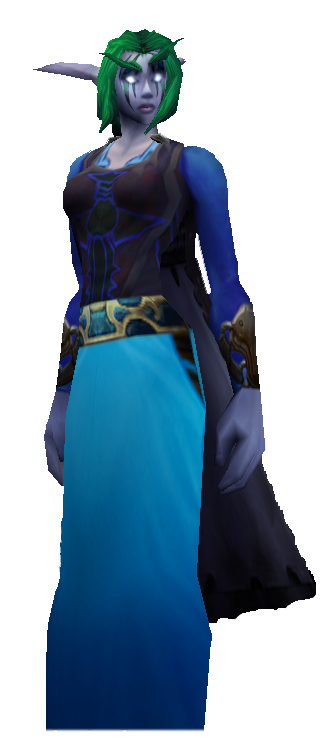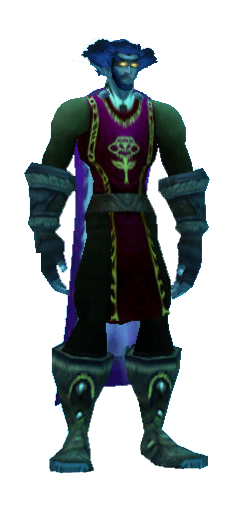 As part of a course under development at The Open University, I was approached as a known World of Warcraft player and asked to write a short paragraph or two on why I play World of Warcraft. I freely admit to failing to only write a short paragraph or two, but that’s probably because I’m passionate about World of Warcraft and my activities in it, especially given the prominence it plays in my life in so many areas. Read on to find out why I play World of Warcraft.
As part of a course under development at The Open University, I was approached as a known World of Warcraft player and asked to write a short paragraph or two on why I play World of Warcraft. I freely admit to failing to only write a short paragraph or two, but that’s probably because I’m passionate about World of Warcraft and my activities in it, especially given the prominence it plays in my life in so many areas. Read on to find out why I play World of Warcraft.

Elsheindra (me)
Hello, my name is Michelle Hoyle. By day, I’m a respectable Open University course author, associate lecturer, and course presentation chair. At night, I assume my secret identity: Elsheindra, night elf guild mistress of The One on a European World of Warcraft (WoW) server. You’re probably thinking that massively multiple online role playing games (MMORPGs), like WoW, are just for kids. In fact, according to research (Lenhart et al, 2008; Yee, 2008), only about 20% of WoW players are between the ages of 12 to 19. That means some 80% of players are solid, upstanding citizens of the world. They could be your tutors. They could be your next door neighbours. They could be that person you see walking down the street or buying beef at the butcher’s. World of Warcraft, as of May 2009, was holding steady at 11.5 million active subscribers (Blandeburgo, 2009; Chuang, 2009). That’s over 60% of the online gaming market. It’s the most successful personal computer game ever to be released.
What is it that compels these people to spend around 20 to 24 hours a week (Hagel and Brown, 2009; Yee, 2005) in a virtual world? Is it the killing? Is it the girls? Is it the beautiful scenery? Is it the fantastic fashions? People’s motivations vary, so I can’t give you a universal motivation, but I can reveal something about why I play. I play for three reasons: because I’m a community builder, because I’m a teacher, and because I love to help people. They’re all a bit related. I have spent my life bringing people together and helping them form cohesive, long-lasting communities. It started back in the 1980s with electronic bulletin boards and continues today with World of Warcraft. That’s why I run a guild and co-lead an alliance of guilds.
A guild in World of Warcraft is a collection of people who share things in common. The game gives them some tools for sharing, like a shared chat area, calendar, and a bank in which to store money or items for common use. They usually share a philosophy. My guild, for example, is a social guild with a philosophy of doing random acts of kindness. An allied guild is composed of people together for friendship or fun. When my guild members aren’t out being kind to the other 4000 people on the server, they have each other to group with on small tasks, called quests, like curing sick deer or ridding an area of nasty rabid bears. A guild is also a pool of people with which to go on longer adventures in groups of five for rewards like armour and gold in mazelike environments where there are obstacles to overcome and difficult, large monsters to kill—so-called dungeons. The alliance of guilds I help lead allows smaller social-minded guilds like mine to be able to participate in even larger, more complex adventures that require 10, 25, or 40 people at a time. It is very rewarding to be in a position to enable people to have fun, but at the same time promote learning of important social interaction and problem solving skills.
Where does the learning come from? The learning is, in fact, everywhere in the game. Those 5-person dungeon groups or the larger 25-person groups require leaders to decide on strategy and direct the other people with varied motivations. Some people go to these dungeons only to get better gear. That’s their motivation. Other people go for the feeling of accomplishment in participating in something difficult. When people are there for gear, there can be clashes over who should get it, which requires good interpersonal relationship skills and diplomacy on the part of the group leader. In our guild alliance, we’ve had leaders good at strategy and telling people what to do but with terrible interpersonal skills. That made their adventures not very fun, so people were reluctant to participate. Likewise, running a successful guild over a long period of time requires all manner of leadership and diplomacy skills. WoW is a safe, low-risk environment in which to learn these things and they can transfer into real-world rewards (Brown and Thomas, 2006).

Elsheindra as a healing tree
In order to contribute to a team effectively, people need to learn to play their characters well. Each character has specific abilities. Elsheindra, my character, is a druid healer. She cures people of diseases and poisons and heal their bodies of damage they have taken while fighting. I’ve specialized in being a healer for over four years. I’ve become really, really good at healing by dint of lots of practice and much analysis of how things work. I have pride in my abilities and I love being able to help people in the game in a non-violent fashion, because I was not much interested in hacking and slashing at things. Other people are extremely interested in effectively killing things and devote hours outside of the game to reading about their character’s role and how to improve on it, often in very tiny increments. I’m very willing to share my knowledge and experience with other people and often other very good players are too.
I’ve told you a lot about what kinds of things I do in World of Warcraft and my initial motivations. What I haven’t told you are the things I’ve gained: love, acceptance, friendship, and a Ph.D. project, in order of importance. I’m currently researching what elements in games like WoW contribute to motivation and whether or not that can be transferred effectively into distance learning (Hoyle, 2009a; 2009b). Both feature activities that are a lot of work and, let’s face it, aren’t fun. In World of Warcraft, though, people persist with these difficult, not-fun tasks. I know I’ve persisted in some things because of the friends I’ve made. Those friendships have even transcended the virtual world, with people helping me move from apartment to apartment multiple times, even though they live in a different city.

Basil, my partner
The alliance of guilds I co-run just had a real-life adventure at Bletchley Park and a BBQ at my house afterwards, one of several such successful large-scale events over the years. It’s also not uncommon for some of my guild mates to just come and visit from other parts of the UK or from other countries. One of my guild mates even came along from Denmark to Canada for the summer. Are we just strange misfits? That’s a common perception of gamers. I don’t fit in lots of places but in WoW there’s a place for me, as there is for them, and it’s not just because “on the Internet nobody knows you’re a dog”. Finally, “Basil”, my real-life partner, is someone I met in WoW because he was helping me co-lead the alliance of guilds. We’ve been together for over two and a half years. We still play WoW together on a regular basis, although not 20 some hours a week. There’s nothing like a romantic date night with your beloved and 23 other friends.
WoW is like a fairy tale: magic, dragons, true love, fashion, elves, and orcs; but it’s also what I’ve made of it: a place to be myself and to do the things I love to do.
References
Blandeburgo, B. (2009) ‘Activision “WoWs,” But Where’s Wireless?’, The Game Trade Journal, blog entry posted March 4, 2009. Available from: http://www.gametradejournal.com/2009/03/activision-wows-but-wheres-wireless.html (Accessed August 4, 2009).
Brown, J.S. & Thomas, D. (2006) ‘You Play World of Warcraft? You’re Hired!’ Wired, 14.04 [Online] Available from: http://www.wired.com/wired/archive/14.04/learn.html (Accessed August 4, 2009).
Chuang, T. (2009) ‘WoW Stuck at 11.5 Million Subscribers; Blizz Focused on StarCraft, Diablo’, OCRegister Blizzard Blog, blog entry posted May 7, 2009. Available from: http://gaming.freedomblogging.com/2009/05/07/wow-stuck-at-115-million-subscribers-blizz-focused-on-starcraft-diablo/2201/ (Accessed August 4, 2009).
Hagel, J. & Brown, J.S. (2009) ‘How World of Warcraft Promotes Innovation’ Business Week Online, January 14 [Online] Available from: http://www.businessweek.com/innovate/content/jan2009/id20090114_362962.htm (Accessed August 4, 2009).
Hoyle, M.A. (2009a) ‘Levelling Lifelong Learning: Annual Progress Review’, E1n1verse, blog entry posted June 7, 2009. Available from: http://einiverse.eingang.org/archives/2009/06/levelling_lifel.php (Accessed August 4, 2009).
Hoyle, M. (2009b) WoW! Roberts & Susans Game Learning, [online] Slide presentation. Available from: http://www.slideshare.net/Eingang/wow-roberts-and-susans-game-learning-a-look-at-world-of-warcraft-higher-education-learning-and-motivation (Accessed August 4, 2009).
Lenhart, A. et al. (2008) Teens, Video Games, and Civics, Pew Internet & American Life Project. Available from: http://www.pewinternet.org/Reports/2008/Teens-Video-Games-and-Civics.aspx (Accessed August 4, 2009).
Yee, N. (2005) ‘MMORPG Hours vs. TV Hours’, The Daedalus Project, blog entry posted January 11, 2005. Available from: http://www.nickyee.com/daedalus/archives/000891.php (Accessed August 4, 2009).
Yee, N. (2008) The Daedulus Project, [online]. Available from: http://www.nickyee.com/daedalus/docs/shared-data.php (Accessed August 4, 2009).
[tweetthis]







